#Amazon Video Direct
Explore tagged Tumblr posts
Text
A little background as to why the Markiplier fandom is panicking about The Edge of Sleep.
So YEARS ago. Mark was in a podcast called The Edge of Sleep, which was adapted into a TV series... Which was never released
Until
Mark made a movie adaptation of a video game, Iron Lung. He's put all his energy into this film, directing, producing, editing, even starring in it. the movie is done, and he's working to get it released in theaters.
We, the public don't know why, but we know that some doors have been locked on the release of Iron Lung, however some big wigs somewhere have promised that if his popularity alone can put Edge of Sleep in the TOP TEN a lot of doors will open for Iron Lung. He wasn't allowed to even say where it would premiere, nor was it advertised AT ALL

So now, Edge of Sleep has shadow dropped on Amazon Prime in the US. Three days BEFORE they even told Mark it would air. In order to get this man's work out in theaters this thing has to get to the top ten by word of mouth alone.
So. Watch Edge of Sleep! It's an apocalyptic horror. There are some mild gore warnings (blood, knife mutilation, brain dissection, self harm). Even if you can play it in the background and let it run just so it gets views thatd be helpful.
Stick it to the Hollywood Bigwigs! Show them YouTubers can have an audience! Open some doors for creative people trying to show their work to a bigger audience!
26K notes
·
View notes
Text

So proud to see that #StupidGames is now available for Rent/Buy on Amazon Prime! Come join us for a fun evening of dinner and spooky board games!
#prime#amazon prime#horror#stupid games#prime video#filmmaking#directing#hollywood#movie#nicolas wendl#mystery#board games#game night#spooky season
0 notes
Text
for whom good omens is being written
Hey maggots and the rest of the fandom, it's the Good Omens Mascot here. Today I read a post about this tweet:

The accompanying video genuinely made me cry. And I've been thinking about this for a long while, as far back as February, when I saw a lot of conflicting opinions on what people wanted from the third season. It really is true that no matter what you do, some people will be dissatisfied. But what matters is that Neil is writing this for Terry.
And I was reminded of some paragraphs from the Good Omens TV Companion, which I'd read in Amazon's sample excerpt of the book. I know this is a long post, but I really truly do think you all need to read these, I've done my best to select only the most important parts. Here you go:
'His Alzheimer's started progressing harder and faster than either of us had expected,' says Neil, referring to a period in which Terry recognized that despite everything he could no longer write. 'We had been friends for over thirty years, and during that time he had never asked me for anything. Then, out of the blue, I received an email from him with a special request. It read: “Listen, I know how busy you are. I know you don't have time to do this, but I want you to write the script for Good Omens. You are the only human being on this planet who has the passion, love and understanding for the old girl that I do. You have to do this for me so that I can see it." And I thought, “OK, if you put it like that then I'll do it."
'I had adapted my own work in the past, writing scripts for Death: The High Cost of Living and Sandman, but not a lot else was seen. I'd also written two episodes of Doctor Who, and so I felt like I knew what I was doing. Usually, having written something once I'd rather start something new, but having a very sick co-author saying I had to do this?' Neil spreads his hands as if the answer is clear to see. 'I had to step up to the plate.' A pause, then: 'All this took place in autumn 2014, around the time that the BBC radio adaptation of Good Omens was happening,' he continues, referring to the production scripted and co-directed by Dirk Maggs and starring Peter Serafinowicz and Mark Heap. ‘Terry had talked me into writing the TV adaptation, and I thought OK, I have a few years. Only I didn't have a few years,' he says. 'Terry was unconscious by December and dead by March.'
He pauses again. 'His passing took all of us by surprise,' Neil remembers. 'About a week later, I started writing, and it was very sad. The moments Terry felt closest to me were the moments I would get stuck during the writing process. In the old days, when we wrote the novel, I would send him what I'd done or phone him up. And he would say, "Aahh, the problem, Grasshopper, is in the way you phrase the question," and I would reply, "Just tell me what to do!" which somehow always started a conversation. 'In writing the script, there were times I'd really want to talk to Terry, and also places where I'd figure something out and do something really clever, and I would want to share it with him. So, instead, I would text Terry's former personal assistant, Rob Wilkins, now his representative on Earth. It was the nearest thing I had.'
(...) As Neil himself recognizes, this is an adaptation built upon the confidence that comes from three decades of writing for page and screen. But for all the wisdom of experience, he found that above all one factor guided him throughout the process. 'Terry isn't here, which leaves me as the guardian of the soul of the story,' he explains. 'It's funny because sometimes I found myself defending Terry's bits harder or more passionately than I would defend my own bits. Take Agnes Nutter,' he says, referring to what has become a key scene in the adaptation in which the seventeenth-century author of the book of prophecies foretelling the coming of the Antichrist is burned at the stake. ‘It was a huge, complicated and incredibly expensive shoot, with bonfires built and primed to explode as well as huge crowds in costume. It had to feel just like an English village in the 1640s, and of course everyone asked if there was a cheap way of doing it. 'One suggestion was that we could tell the story using old-fashioned woodcuts and have the narrator take us through what happened, but I just thought, “No”. Because I had brought aspects of the story like Crowley and the baby swap along to the mix, and Terry created Agnes Nutter. So, if I had cut out Agnes then I wouldn't be doing right by the person who gave me this job. Terry would've rolled over in his grave.'
And, finally, this paragraph:
"Once again, Neil cites the absence of his co-writer as his drive to ensure that Good Omens translated to the screen and remained true to the original vision. 'Terry's last request to me was to make this something he would be proud of. And so that has been my job.'"
I think that's so heartwrenchingly beautiful, and so I wanted you all to read this, too, just in case you (like me) don't have the Good Omens TV Companion. It adds another layer of depth and emotion to this already complex and amazing story that we all know and love.
Share this post, if you can, please, so that more people can read these excerpts :")
Tagging @neil-gaiman, @fuckyeahgoodomens and @orpiknight, even if you've definitely read these before :)
#good omens#neil gaiman#sir terry pratchett#good omens show#good omens fandom#good omens mascot#weirdly specific but ok#asmi
15K notes
·
View notes
Text
'Like A Dragon: Yakuza' Live-Action Series Hits Amazon Prime Video This October
New Post has been published on https://thedigitalinsider.com/like-a-dragon-yakuza-live-action-series-hits-amazon-prime-video-this-october/
'Like A Dragon: Yakuza' Live-Action Series Hits Amazon Prime Video This October

Amazon has announced Like a Dragon: Yakuza, a live-action television series adaptation of Ryu Ga Gotoku Studios and Sega’s long-running Like a Dragon (formerly Yakuza) series. It will be a story centered on series mainstay Kazuma Kiryu and will follow his life in 1995 and 2005 across six episodes.
The first three episodes drop Oct. 25 and the last three episodes hit Amazon Prime Video on Nov. 1, and, according to Variety, the series will be subbed and dubbed in 30 languages.
The logline for the series describes it as a story set in two time periods – 1995 and 2005 – and follows the life, childhood friendships, and repercussions of the decisions of Kazuma Kiryu, a Yakuza warrior with a strong sense of justice, duty, and humanity. If you’re familiar with the series, given the time periods at play here, it sounds like Like a Dragon: Yakuza could be loosely adapting the storyline of Yakuza 1.
Take Masaharu (100 Yen Love) is directing the series alongside Takimoto Kengo (Kamen Rider), and stars Takeuchi Ryoma (various Kamen Rider movies and series) as Kazuma Kiryu. You can see him in the image below:

Variety reports Like a Dragon: Yakuza will “depict the lives of fierce yet passionate gangsters and people living in a huge entertainment district, Kamurochō, a fictional district modeled after the violent Shinjuku ward’s Kabukichō, that acts as the backdrop of the gameplay.” Amazon says the series “showcases modern Japan and the dramatic stories of these intense characters, such as the legendary Kazuma Kiryu, that games in the past have not been able to explore.”
Ryu Ga Gotoku Studios studio head and series executive producer Yokoyama Masayoshi told Variety the following:
“Since the day I first put pen to paper on the original Yakuza script, I’ve never once thought about revisitng any of my work on the series. It’s because I understand all too well the challenges and hardships that come with remaking a finished title. However, if I were ever sent to the past through some kind of cosmic joke, this is the experience I’d want to create. If I had to go through the wringer anyhow, I’d want to make the most engaging versions of Kamurochō and Kazuma Kiryu I could – and this show has it all.
“While the games let you experience their world through the subjective lens, this adaptation will be the ultimately objective way to enjoy the show. I have no doubt fans of the series will be drawn to how it brings the games to life and adds new surprises. Newcomers, I’m sure, will find themselves invested simply in the gritty realism of the show.”
Like a Dragon: Yakuza hits Amazonz Prime Video starting on Oct. 25 and will finish on Nov. 1 this year.
News of this series follows the release of Like a Dragon: Infinite Wealth, the eighth mainline installment in the video game series, back in January. You can read Game Informer’s Like a Dragon: Infinite Wealth review here. After that, read Game Informer’s exclusive interview with the leads behind the Like a Dragon series to learn about the future of Ryu Ga Gotoku studio while visiting its offices.
Are you excited about Like a Dragon: Yakuza? Let us know in the comments below!
#Amazon#amazon prime#directing#entertainment#Future#game#games#how#INterview#it#Japan#justice#Languages#Learn#lens#life#movies#News#paper#Play#Read#reports#review#sounds#stars#Stories#Television#time#Video#wealth
0 notes
Text
Todd Spangler at Variety:
Diamond Sports Group has put together a plan to emerge from bankruptcy and remain a going concern, helped by a big new streaming deal with Amazon. Amazon has committed to making a minority investment in Diamond Sports Group, one of the largest operators of regional sports networks (RSNs) in the country, as part of Diamond’s bankruptcy reorganization plan, the RSN company announced Wednesday. Under the terms of Amazon’s investment, the tech giant will enter into a commercial arrangement to provide access to Diamond’s services via Prime Video. Prime Video will become Diamond’s primary partner through which customers will be able to purchase direct-to-consumer access to stream local Diamond channels. Customers will be able to access all local DTC content, including live MLB, NBA and NHL games, and pre- and post-game programming, for the teams for which Diamond retains DTC rights, through Prime Video Channels. Diamond said additional details regarding pricing and availability of its RSNs via Prime Video will be announced at a later date. In addition, the company said it “looks forward to continuing to partner with its existing [pay TV] distribution partners to broadcast its MLB, NBA and NHL content.” Diamond’s regional sports networks produce nearly 4,500 live local professional telecasts each year in addition to a variety of locally produced sports events and programs. It owns and operates the 18 Bally Sports regional sports networks, which are the TV home to half of all MLB, NHL and NBA teams in the U.S., according to the company. Those are: Bally Sports Detroit, Bally Sports Florida, Bally Sports Great Lakes, Bally Sports Indiana, Bally Sports Kansas City, Bally Sports Midwest, Bally Sports New Orleans, Bally Sports North, Bally Sports Ohio, Bally Sports Oklahoma, Bally Sports San Diego, Bally Sports SoCal, Bally Sports South, Bally Sports Southeast, Bally Sports Southwest, Bally Sports Sun, Bally Sports West, and Bally Sports Wisconsin. Diamond Sports Group also has a joint venture in Marquee, home of the Chicago Cubs, and a minority interest in the YES Network, the destination for the New York Yankees and Brooklyn Nets.
Diamond also announced Wednesday that it has an agreement in principle with parent Sinclair to settle the pending litigation between the companies. In July 2023, Diamond sued Sinclair alleging the company had fraudulently withdrawn as much as $1.5 billion from the RSN business. Sinclair had formed Diamond in 2019 after acquiring 21 Fox RSNs in a $10.6 billion deal with Disney, as part of getting regulatory approval for Disney’s acquisition of the 21st Century Fox film and TV assets.
Amazon will acquire a stake in Diamond Sports Group to stream teams on DSG-owned outlets to be streamed on Amazon Prime Video as a way for Diamond Sports Group to stay operable past 2024.
#Sports Media#Bally Sports#Diamond Sports Group#Amazon Prime Video#Amazon#Direct To Consumer#DTC#Streaming#Sinclair Broadcast Group#Regional Sports Networks#RSNs
0 notes
Text
Chinese Censorship of the 2023 Hugo Award Nominations
Back before the 2023 Hugo Nominations were conducted, I noted that the Chengdu Worldcon Hugo committee had inserted a worrying clause indicating that local government officials could invalidate nominations for breaching the norms and standards of China. I suspected this would result in arbitrarily applied censorship to control the ballot. I am sad and unsurprised to discover I was correct.
The 2023 Hugo Nomination vote data has been published (https://www.thehugoawards.org/2024/01/2023-nominating-and-final-ballot-statistics-published/), and includes notation where nominations were excluded from the ballot. Those with normal reasons, such as being in the wrong category or not being published in 2022 are identified with their reasons for exclusion. This time there are a number of nominations that are merely marked at "Not eligible".
Here is the list of those nominations, that would otherwise have been placed on the final 2023 Hugo Award Ballot.
Babel - R.F. Kuang - Best Novel: Very likely excluded for referencing student revolution, and the use of language and translation as coercive tools of oppression. Color the World - Congyun "Mu Ming" Hu - Best Novellette : A story about perception of, aid of, and discrimination against disability. Congyun Hu has left China and now lives in New York. Fogong Temple Padoga - Hai Ya - Best Story : Either there is something in the original Chinese that was not translated, there's a taboo subject that elides my reading, or this otherwise innocent looking near future tale of cultural building restoration was written by the wrong person. The Art of Ghost of Tsushima: Dark Horse and Sucker Punch Games - Best Related Work : The video game Ghost of Tsushima was subject to directed social exclusion for it's depiction of the Mongol invasion of Japan. Sandman, Amazon Studios: Best Dramatic Presentation (Long and Short) - A diverse and divergent cast, includes subject matter and social issues that are currently taboo in China. Paul Weimer - Fan Writer: Publicly Critical of holding a Worldcon in China. Xiran Jay Zhao - Astounding Award: Qualifying work "Iron Widow" is reimagined story of Chinese Empress Wu during a fantasy/mechanical alien invasion.
This raises a lot of questions as to if this basically taints the process, and what can be done about it.
#hugo awards#babel#r.f. kuang#color the world#mu ming#congyun hu#fogon temple padoga#hai ya#Ghost of Tshuima#Sandman#neil gaiman#paul weimer#xiran jay zhao#iron widdow#censorship#china#chengdu 2023#worldcon
5K notes
·
View notes
Text
Prime’s enshittified advertising
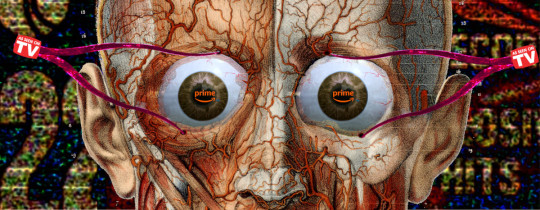
Prime's gonna add more ads. They brought in ads in January, and people didn't cancel their Prime subscriptions, so Amazon figures that they can make Prime even worse and make more money:
https://arstechnica.com/gadgets/2024/10/amazon-prime-video-is-getting-more-ads-next-year/
The cruelty isn't the point. Money is the point. Every ad that Amazon shows you shifts value away from you – your time, your attention – to the company's shareholders.
That's the crux of enshittification. Companies don't enshittify – making their once-useful products monotonically worse – because it amuses them to erode the quality of their offerings. They enshittify them because their products are zero-sum: the things that make them valuable to you (watching videos without ads) make things less valuable to them (because they can't monetize your attention).
This isn't new. The internet has always been dominated by intermediaries – platforms – because there are lots more people who want to use the internet than are capable of building the internet. There's more people who want to write blogs than can make a blogging app. There's more people who want to play and listen to music than can host a music streaming service. There's more people who want to write and read ebooks than want to operate an ebook store or sell an ebooks reader.
Despite all the early internet rhetoric about the glories of disintermediation, intermediaries are good, actually:
https://pluralistic.net/2022/06/12/direct-the-problem-of-middlemen/
The problem isn't with intermediaries per se. The problem arises when intermediaries grow so powerful that they usurp the relationship between the parties they connect. The problem with Uber isn't the use of mobile phones to tell taxis that you're standing on a street somewhere and would like a cab, please. The problem is rampant worker misclassification, regulatory arbitrage, starvation wages, and price-gouging:
https://pluralistic.net/2024/02/29/geometry-hates-uber/#toronto-the-gullible
There's no problem with publishers, distributors, retailers, printers, and all the other parts of the bookselling ecosystem. While there are a few, rare authors who are capable of performing all of these functions – basically gnawing their books out of whole logs with their teeth – most writers can't, and even the ones who can, don't want to:
https://pluralistic.net/2024/02/19/crad-kilodney-was-an-outlier/#intermediation
When early internet boosters spoke of disintermediation, what they mostly meant was that it would be harder for intermediaries to capture those relationships – between sellers and buyers, creators and audiences, workers and customers. As Rebecca Giblin and I wrote in our 2022 book Chokepoint Capitalism, intermediaries in every sector rely on chokepoints, narrows where they can erect tollbooths:
https://chokepointcapitalism.com/
When chokepoints exist, they multiply up and down the supply chain. In the golden age of physical, recorded music, you had several chokepoints that reinforced one another. Limited radio airwaves gave radio stations power over record labels, who had to secretly, illegally bid for prime airspace ("payola"). Retail consolidation – the growth of big record chains – drove consolidation in the distributors who sold to the chains, and the more concentrated distributors became, the more they could squeeze retailers, which drove even more consolidation in record stores. The bigger a label was, the more power it had to shove back against the muscle of the stores and the distributors (and the pressing plants, etc). Consolidation in labels also drove consolidation in talent agencies, whose large client rosters gave them power to resist the squeeze from the labels. Consolidation in venues drives consolidation in ticketing and promotion – and vice-versa.
But there's two parties to this supply chain who can't consolidate: musicians and their fans. With limits on "sectoral bargaining" (where unions can represent workers against all the companies in a sector), musicians' unions were limited in their power against key parts of the supply chain, so the creative workers who made the music were easy pickings for labels, talent reps, promoters, ticketers, venues, retailers, etc. Music fans are diffused and dispersed, and organized fan clubs were usually run by the labels, who weren't about to allow those clubs to be used against the labels.
This is a perfect case-study in the problems of powerful intermediaries, who move from facilitator to parasite, paying workers less while degrading their products, and then charge customers more for those enshittified products.
The excitement about "disintermediation" wasn't so much about eliminating intermediaries as it was about disciplining them. If there were lots of ways to market a product or service, sell it, collect payment for it, and deliver it, then the natural inclination of intermediaries to turn predator would be curbed by the difficulty of corralling their prey into chokepoints.
Now that we're a quarter century on from the Napster Wars, we can see how that worked out. Decades of failure to enforce antitrust law allowed a few companies to effectively capture the internet, buying out rivals who were willing to sell, and bankrupting those who wouldn't with illegal tactics like predatory pricing (think of Uber losing $31 billion by subsidizing $0.41 out of every dollar they charged for taxi rides for more than a decade).
The market power that platforms gained through consolidation translated into political power. When a few companies dominate a sector, they're able to come to agreement on common strategies for dealing with their regulators, and they've got plenty of excess profits to spend on those strategies. First and foremost, platforms used their power to get more power, lobbying for even less antitrust enforcement. Additionally, platforms mobilized gigantic sums to secure the right to screw customers (for example, by making binding arbitration clauses in terms of service enforceable) and workers (think of the $225m Uber and Lyft spent on California's Prop 22, which formalized their worker misclassification swindle).
So big platforms were able to insulate themselves from the risk of competition ("five giant websites, filled with screenshots of the other four" – Tom Eastman), and from regulation. They were also able to expand and mobilize IP law to prevent anyone from breaking their chokepoints or undoing the abuses that these enabled. This is a good place to get specific about how Prime Video works.
There's two ways to get Prime videos: over an app, or in your browser. Both of these streams are encrypted, and that's really important here, because of a law – Section 1201 of the 1998 Digital Millennium Copyright Act – which makes it really illegal to break this kind of encryption (commonly called "Digital Rights Management" or "DRM"). Practically speaking, that means that if a company encrypts its videos, no one is allowed to do anything to those videos, even things that are legal, without the company's permission, because doing all those legal things requires breaking the DRM, and breaking the DRM is a felony (five years in prison, $500k fine, for a first offense).
Copyright law actually gives subscribers to services like Prime a lot of rights, and it empowers businesses that offer tools to exercise those rights. Back in 1976, Sony rolled out the Betamax, the first major home video recorder. After an eight-year court battle, the Supreme Court weighed in on VCRs and ruled that it was legal for all of us to record videos at home, both to watch them later, and to build a library of our favorite shows. They also ruled that it was legal for Sony – and by that time, every other electronics company – to make VHS systems, even if those systems could be used in ways that violated copyright because they were "capable of sustaining a substantial non-infringing use" (letting you tape shows off your TV).
Now, this was more than a decade before the DMCA – and its prohibition on breaking DRM – passed, but even after the DMCA came into effect, there was a lot of media that didn't have DRM, so a new generation of tech companies were able to make tools that were "capable of sustaining a substantial non-infringing use" and that didn't have to break any DRM to do it.
Think of the Ipod and Itunes, which, together, were sold as a way to rip CDs (which weren't encrypted), and play them back from both your desktop computer and a wildly successful pocket-sized portable device. Itunes even let you stream from one computer to another. The record industry hated this, but they couldn't do anything about it, thanks to the Supreme Court's Betamax ruling.
Indeed, they eventually swallowed their bile and started selling their products through the Itunes Music Store. These tracks had DRM and were thus permanently locked to Apple's ecosystem, and Apple immediately used that power to squeeze the labels, who decided they didn't like DRM after all, and licensed all those same tracks to Amazon's DRM-free MP3 store, whose slogan was "DRM: Don't Restrict Me":
https://memex.craphound.com/2008/02/01/amazons-anti-drm-tee/
Apple played a funny double role here. In marketing Itunes/Ipods ("Rip, Mix, Burn"), they were the world's biggest cheerleaders for all the things you were allowed to do with copyrighted works, even when the copyright holder objected. But with the Itunes Music Store and its mandatory DRM, the company was also one of the world's biggest cheerleaders for wrapping copyrighted works in a thin skin of IP that would allow copyright holders to shut down products like the Ipod and Itunes.
Microsoft, predictably enough, focused on the "lock everything to our platform" strategy. Then-CEO Steve Ballmer went on record calling every Ipod owner a "thief" and arguing that every record company should wrap music in Microsoft's Zune DRM, which would allow them to restrict anything they didn't like, even if copyright allowed it (and would also give Microsoft the same abusive leverage over labels that they famously exercised over Windows software companies):
https://web.archive.org/web/20050113051129/http://management.silicon.com/itpro/0,39024675,39124642,00.htm
In the end, Amazon's approach won. Apple dropped DRM, and Microsoft retired the Zune and shut down its DRM servers, screwing anyone who'd ever bought a Zune track by rendering that music permanently unplayable.
Around the same time as all this was going on, another company was making history by making uses of copyrighted works that the law allowed, but which the copyright holders hated. That company was Tivo, who products did for personal video recorders (PVRs) what Apple's Ipod did for digital portable music players. With a Tivo, you could record any show over cable (which was too expensive and complicated to encrypt) and terrestrial broadcast (which is illegal to encrypt, since those are the public's airwaves, on loan to the TV stations).
That meant that you could record any show, and keep it forever. What's more, you could very easily skip through ads (and rival players quickly emerged that did automatic ad-skipping). All of this was legal, but of course the cable companies and broadcasters hated it. Like Ballmer, TV execs called Tivo owners "thieves."
But Tivo didn't usher in the ad-supported TV apocalypse that furious, spittle-flecked industry reps insisted it would. Rather, it disciplined the TV and cable operators. Tivo owners actually sought out ads that were funny and well-made enough to go viral. Meanwhile, every time the industry decided to increase the amount of advertising in a show, they also increased the likelihood that their viewers would seek out a Tivo, or worse, one of those auto-ad-skipping PVRs.
Given all the stink that TV execs raised over PVRs, you'd think that these represented a novel threat. But in fact, the TV industry's appetite for ads had been disciplined by viewers' access to new technology since 1956, when the first TV remotes appeared on the market (executives declared that anyone who changed the channel during an ad-break was a thief). Then came the mute button. Then the wireless remote. Meanwhile, a common VCR use-case – raised in the Supreme Court case – was fast-forwarding ads.
At each stage, TV adapted. Ads in TV shows represented a kind of offer: "Will you watch this many of these ads in return for a free TV show?" And the remote, the mute button, the wireless remote, the VCR, the PVR, and the ad-skipping PVR all represented a counter-offer. As economists would put it, the ability of viewers to make these counteroffers "shifted the equilibrium." If viewers had no defensive technology, they might tolerate more ads, but once they were able to enforce their preferences with technology, the industry couldn't enshittify its product to the liminal cusp of "so many ads that the viewer is right on the brink of turning off the TV (but not quite)."
This is the same equilibrium-shifting dynamic that we see on the open web, where more than 50% of users have installed an ad-blocker. The industry says, "Will you allow this many 'sign up to our mailing list' interrupters, pop ups, pop unders, autoplaying videos and other stuff that users hate but shareholders benefit from" and the ad-blocker makes a counteroffer: "How about 'nah?'":
https://www.eff.org/deeplinks/2019/07/adblocking-how-about-nah
TV remotes, PVRs and ad-blockers are all examples of "adversarial interoperability" – a new product that plugs into an existing one, extending or modifying its functions without permission from (or even over the objections of) the original manufacturer:
https://www.eff.org/deeplinks/2019/10/adversarial-interoperability
Adversarial interop creates a powerful disciplining force on platform owners. Once a user grows so frustrated with a product's enshittification that they research, seek out, acquire and learn to use an adversarial interop tool, it's really game over. The printer owner who figures out where to get third-party ink is gone forever. Every time a company like HP raises its prices, they have to account for the number of customers who will finally figure out how to use generic ink and never, ever send another cent to HP.
This is where DMCA 1201 comes into play. Once a product is skinned with DRM, its manufacturers gain the right to prevent you from doing legal things, and can use the public's courts and law-enforcement apparatus to punish you for trying. Take HP: as soon as they started adding DRM to their cartridges, they gained the legal power to shut down companies that cloned, refilled or remanufactured their cartridges, and started raising the price of ink – which today sits at more than $10,000/gallon:
https://pluralistic.net/2024/09/30/life-finds-a-way/#ink-stained-wretches
Using third party ink in your printer isn't illegal (it's your printer, right?). But making third party ink for your printer becomes illegal once you have to break DRM to do so, and so HP gets to transform tinted water into literally the most expensive fluid on Earth. The ink you use to print your kid's homework costs more than vintage Veuve Cliquot or sperm from a Kentucky Derby-winning thoroughbred.
Adversarial interoperability is a powerful tool for shifting the equilibrium between producers, intermediaries and buyers. DRM is an even more powerful way of wrenching that equilibrium back towards the intermediary, reducing the share that buyers and sellers are able to eke out of the transaction.
Prime Video, of course, is delivered via an app, which means it has DRM. That means that subscribers don't get to exercise the rights afforded to them by copyright – only the rights that Amazon permits them to have. There's no Tivo for Prime, because it would have to break the DRM to record the shows you stream from Prime. That allows Prime to pull all kinds of shady shit. For example, every year around this time, Amazon pulls popular Christmas movies from its free-to-watch tier and moves them into pay-per-view, only restoring them in the spring:
https://www.reddit.com/r/vudu/comments/1bpzanx/looks_like_amazon_removed_the_free_titles_from/
And of course, Prime sticks ads in its videos. You can't skip these ads – not because it's technically challenging to make a 30-second advance button for a video stream, and doing so wouldn't violate anyone's copyright – but because Amazon doesn't permit you to do so, and the fact that the video is wrapped in DRM makes it a felony to even try.
This means that Amazon gets to seek a different equilibrium than TV companies have had to accept since 1956 and the invention of the TV remote. Amazon doesn't have to limit the quantity, volume, and invasiveness of its ads to "less the amount that would drive our subscribers to install and use an ad-skipping plugin." Instead, they can shoot for the much more lucrative equilibrium of "so obnoxious that the viewer is almost ready to cancel their subscription (but not quite)."
That's pretty much exactly how Kelly Day, the Amazon exec in charge of Prime Video, put it to the Financial Times: they're increasing the number of ads because "we haven’t really seen a groundswell of people churning out or cancelling":
https://www.ft.com/content/f8112991-820c-4e09-bcf4-23b5e0f190a5
At this point, attentive readers might be asking themselves, "Doesn't Amazon have to worry about Prime viewers who watch in their browsers?" After all browsers are built on open standards, and anyone can make one, so there should be browsers that can auto-skip Prime ads, right?
Wrong, alas. Back in 2017, the W3C – the organization that makes the most important browser standards – caved to pressure from the entertainment industry and the largest browser companies and created "Encrypted Media Extensions" (EME), a "standard" for video DRM that blocks all adversarial interoperability:
https://www.eff.org/deeplinks/2017/09/open-letter-w3c-director-ceo-team-and-membership
This had the almost immediate effect of making it impossible to create an independent browser without licensing proprietary tech from Google – now a convicted monopolist! – who won't give you a license if you implement recording, ad-skipping, or any other legal (but dispreferred) feature:
https://blog.samuelmaddock.com/posts/the-end-of-indie-web-browsers/
This means that for Amazon, there's no way to shift value away from the platform to you. The company has locked you in, and has locked out anyone who might offer you a better deal. Companies that know you are technologically defenseless are endlessly inventive in finding ways to make things worse for you to make things better for them. Take Youtube, another DRM-video-serving platform that has jacked up the number of ads you have to sit through in order to watch a video – even as they slash payments to performers. They've got a new move: they're gonna start showing you ads while your video is paused:
https://www.usatoday.com/story/money/2024/09/20/youtube-pause-ads-rollout/75306204007/
That is the kind of fuckery you only come up with when your victory condition is "a service that's almost so bad our customers quit (but not quite)."
In Amazon's case, the math is even worse. After all, Youtube may have near-total market dominance over a certain segment of the video market, but Prime Video is bundled with Prime Delivery, which the vast majority of US households subscribe to. You have to give up a lot to cancel your Prime subscription – especially since Amazon's predatory pricing devastated the rest of the retail sector:
https://pluralistic.net/2022/11/28/enshittification/#relentless-payola
Amazon's founding principle was "customer obsession." Ex-Amazoners tell me that this was more than an empty platitude: arguments over product design were won or lost based on whether they could satisfy the "customer obsession" litmus test. Now, everyone falls short of their ideals, but sticking to your ideals isn't merely a matter of internal discipline, of willpower. Living up to your ideals is a matter of external discipline, too. When Amazon no longer had to contend with competitors or regulators, when it was able to use DRM to control its customers and use the law to prevent them from using its products in legal ways, it lost those external sources of discipline.
Amazon suppliers have long complained of the company's high-handed treatment of the vendors who supplied it with goods. Its workers have complained bitterly and loudly about the dangerous and oppressive conditions in its warehouses and delivery vans. But Amazon's customers have consistently given Amazon high marks on quality and trustworthiness.
The reason Amazon treated its workers and suppliers badly and its customers well wasn't that it liked customers and hated workers and suppliers. Amazon was engaged in a cold-blooded calculus: it understood that treating customers well would give it control over those customers, and that this would translate market power to retain suppliers even as it ripped them off and screwed them over.
But now, Amazon has clearly concluded that it no longer needs to keep customers happy in order to retain them. Instead, it's shooting for "keeping customers so angry that they're almost ready to take their business elsewhere (but not quite)." You see this in the steady decline of Amazon product search, which preferences the products that pay the biggest bribes for search placement over the best matches:
https://pluralistic.net/2023/11/06/attention-rents/#consumer-welfare-queens
And you see it in the steady enshittification of Prime Video. Amazon's character never changed. The company always had a predatory side. But now that monopoly and IP law have insulated it from consequences for its actions, there's no longer any reason to keep the predator in check.

Tor Books as just published two new, free LITTLE BROTHER stories: VIGILANT, about creepy surveillance in distance education; and SPILL, about oil pipelines and indigenous landback.
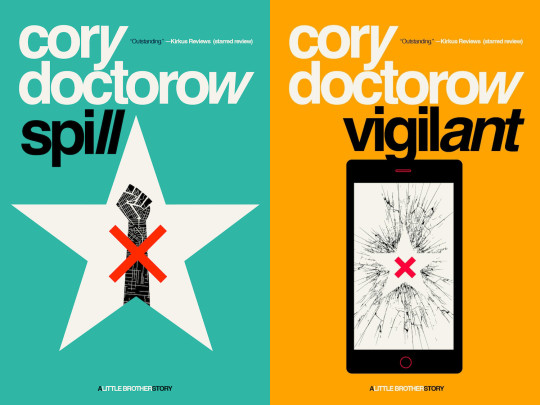

If you'd like an essay-formatted version of this post to read or share, here's a link to it on pluralistic.net, my surveillance-free, ad-free, tracker-free blog:
https://pluralistic.net/2024/10/03/mother-may-i/#minmax
768 notes
·
View notes
Text
i am really so sorry to continue harping on about the watcher entertainment streaming service. but this kind of stuff (internet content as a business & marketing it as such) is truly my obsession, and i think i will implode if i don't talk about some of the takes i'm seeing.
i'd like to emphasize again i don't have strong feelings about watcher either way. i like ghost files, i watch mystery files sometimes, i watched worth it back in the buzzfeed days. i don't watch any of their shows religiously.
anyway, here's the main things i keep seeing crop up and my thoughts on each:
"watcher has 25 employees they have to pay, and employing people in this economy is good, so we should be banding together to pay them."
employing people is good if you currently have the capacity to pay them. i checked watcher's linkedin page, and many of their employees were hired within the last year or two. if they hired people they cannot pay with the business model they had before, something is seriously wrong with their internal bookkeeping/decision making. it means they either didn't know they couldn't pay these people long term, or they did know and were content with risking newly hired employees' livelihoods on a huge content pivot in the next year.
of note is that none of their employees' titles have anything to do with managing the finances of the company. they are the size of a small business but have no one aside from the figureheads of the company in charge of their finances.
this is the kind of company decision making that leads to downsizing and layoffs, which can be devastating. but you know what's worse than laying off a portion of your staff? laying off everyone because your business is going under.
"not everyone can afford the subscription, but those who can should pay it to support the watcher team."
no. $6/month for a couple hours of content (depending on what shows you actively watch and the natural fluctuation of their release schedule) is a fundamentally bad value. i can pay that much for a few movies on amazon. i can pay that much for dropout, if i want to support a smaller business instead.
and to be totally frank, even if people do sign up, i don't think they'd get enough to compete with the amount they get through patreon/sponsorships. and the fact that they didn't know how many of their subscribers would realistically sign up is a bad sign.
a pretty good conversion rate of free to paid subscribers of a service or content is 3% (usually accomplished through a free trial). given the very poor reception of the announcement, let's say about 1% of their 3 mil youtube subs pay for their service. that's 30k people paying for their new platform. that's $180k a month in their pocket.
(they currently only have 12k subs on patreon so we are being generous here.)
a sponsorship deal (based on my googling, i have less direct experience with this) is anywhere from $10-50 per 1000 views. they've gotten about 1 mil views on their last few videos. 3 mil subs is nothing to shake a stick at, but let's say they're on the lower end of the payscale at $25 per 1000 views. that's $25k a video, $100k a month if they release 1 video a week. their lowest patreon tier is 5 bucks, so even if all their subs are at that tier, that's another $60k, so $160k total. it's entirely likely they're bringing in much more than that when you factor in merch, adsence, etc.
did anyone on their team crunch numbers on how many people would need to sub to make the switch worth it? did anyone do market research on how many people they could convert to paid users? because if not, if they really didn't have a game plan for this, the subscription service was always doomed to fail.
"this was their only option to continue making the content they want to make, with the production value they want."
i watched their announcement video. a key point in that video is that they have done sponsored videos and that's what used to pay for their content, but they did not like the amount of creative control the sponsor had over the content.
look, i get that's no fun. we'd all love creatives to be able to make whatever they want. but when you are a small business with a team of employees relying on you, you have to think about making money, sometimes at the cost of creative liberties.
and they had so many other options to make money for the projects they want to make without jumping to a subscription platform.
they could have started actually promoting their patreon, and maybe done some restructuring of the tiers. why not a highly produced, special series just for patreon members? or a special high-budget episode of each series, while the main series is lower budget?
bite the bullet and continue taking sponsorship deals on some less-produced shows, while axing sponsorships from the ones the crew feels more passionate about.
schedule larger, blowout-production shows only when they can be afforded. this is what Notorious Amongus Guy streamer jerma does. he saves up for big productions like his baseball or dollhouse streams, so he can really get creative with them.
they had other options and they've tried very little, especially when you compare them to other content house business at similar scales. try guys and good mythical morning both put out significant content with significant staff, and have had to diversify their income streams with auxiliary products, shows with widely varied levels of production, etc. but it seems to be working for them. watcher has merch and that's about it, and seems to only want to increase the production quality of ALL their shows.
really, all this just boils down to a terrible business decision. it's hard to say if the watcher team is working with a consultant or anyone outside of their team, but they certainly don't have anyone internally who is experienced with running a business like this. to me, it seems very much like they got in a room together and did some extremely optimistic income ballparking with no research behind it.
and that might have been fine for three dudes running a channel alone, but if they're a business, they have to start making decisions like one.
#i encourage discussion on this in my notes btw!#you can even be mean to me if you disagree. i dont actually care#watcher
897 notes
·
View notes
Text
New Hazbin Hotel Post from Amazon Prime on twt/X
I noticed something while watching the video.
Angels are portrait in white.

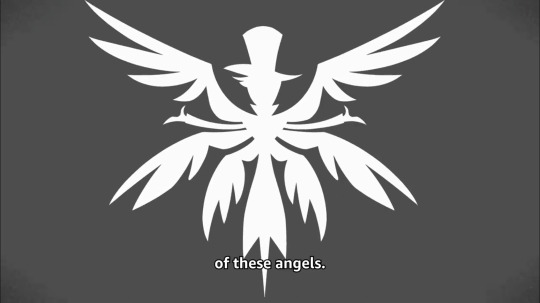

Except when they are shown in direct connection with hell.
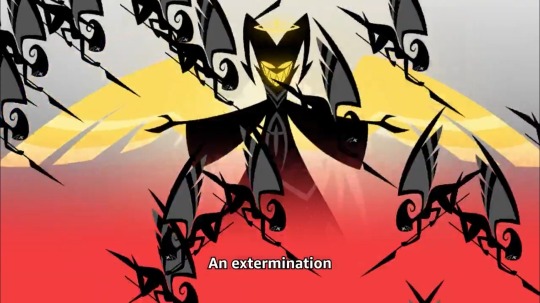
Everyone else is generally portrait in black or dark gray.

And everything that is related to the fall of man or hell itself is highlighted in red.


Charlie on the other hand is shown in white, but still keeps her red eyes.
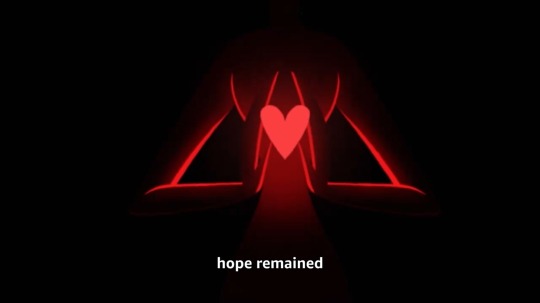

She is the only one who is, despite the direct connection with hell, which is even shown behind her and despite the red eyes, depicted in white.
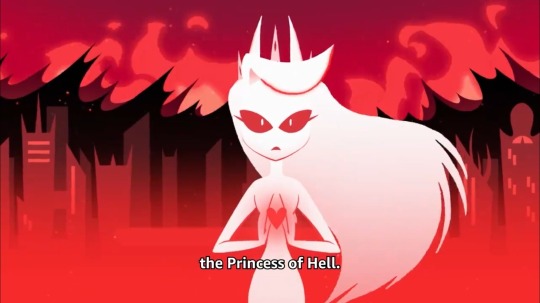
This all really shows her special importance to both heaven and hell. Not only through her decent as Lucifer's and Lilith's daughter, but also through her plan to redeame Sinner.
#hazbin hotel#hazbin#hellaverse#charlie magne#charlie morningstar#charlie hazbin hotel#charlie magne hazbin hotel#charlie morningstar hazbin hotel#hazbin hotel charlie morningstar#hazbin hotel charlie magne#hazbin hotel charlie#lucifer magne#lucifer morningstar#lucifer magne hazbin hotel#lucifer morningstar hazbin hotel#hazbin hotel lucifer magne#hazbin hotel lucifer morningstar#hazbin hotel lucifer
741 notes
·
View notes
Text
ADHD money/budgeting system I'm currently using for my benefit is going well (I've been using it for like half a year now?), and I wanna recommend it.
You Need a Budget is EXCELLENT. 10/10 do recommend. Uhhh rambling about it and my generic disclaimers + gushing extensively under the cut but TL;DR I think it's great for ADHD ppl, I've used it for 6+ months now and I find it super SUPER helpful. also weirdly fun.
DISCLAIMERS:
Budgeting helps you understand/know your money, it can't make money appear where there is none.
Everyone should learn to budget even if you don't have much money (especially then)
This is NOT a magic trick solution. Just like everything else, it is an assistive tool. This is one of those adult things we can't simply opt out of without negative consequences, though.
My advice is based on something I am currently able to do. That is, I can spend an amount of money on this specific thing that works well for me. If you have no extra money to spend then previously I was tracking things in a notebook. So you can still do this.
I believe Dave Ramsey is a fundie fraud/hack and no one should listen to him about money.
DID YOU KNOW THEY CANCELLED MINT???
Okay? OKAY.
Ahem.
You Need a Budget is EXCELLENT.
It is called YNAB for short. The first 34 days are your free trial, and that is my referral link. If anyone uses it and then signs up for a subscription, we both get a month free. Also you can share a subscription with up to six people (account owner can see everything but individuals can pick and choose what they share amongst each other) so like...idk your whole polycule can be on one account. Or your kids. Whatever.
If you are a student, it's free for a year. If you aren't, a subscription is $99 for a year (paid all at once) or $14.99 monthly, which is equivalent to paying Amazon prime. Go cancel Prime and get this instead tbh.
They got a whole article just on ynab and ADHD. They also have like...a big variety of ways to access their info? They have a book, podcast episodes, YouTube videos, blog posts, q&A's, free live workshops you can join (you can request live captioning), emails they can send (if you want) a wiki, and so on. They got workshops on all kinds of topics!!
So whatever ends up working for your brain. It also has a matching app.
If you lost Mint this year they have a gajillion things for moving from Mint.
Also they have a "got five minutes?" Page which has a slider so you can decide how much attention/time you have before going on lol:

They only have 4 rules of the budget, they're simple and practical, and it doesn't get judgey or like...mean about your spending.
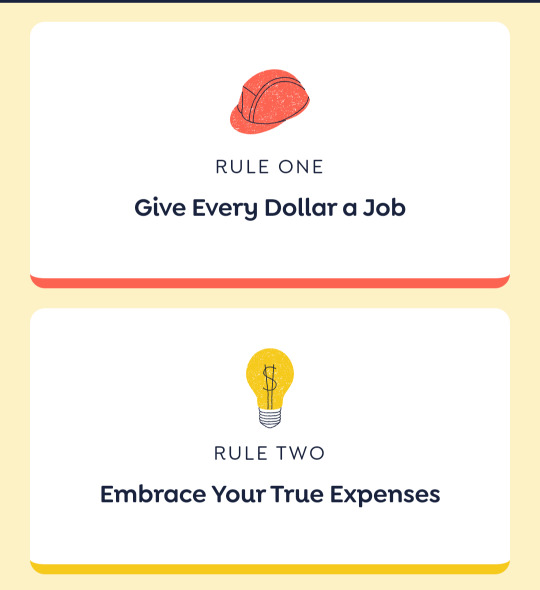
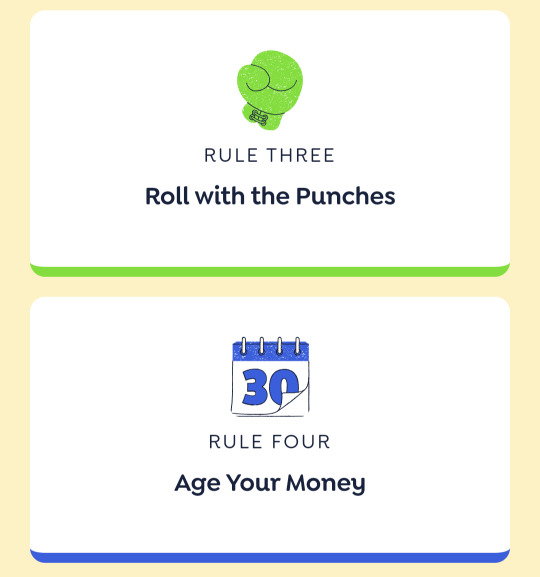
1. Give every dollar a job 2. Embrace your true expenses 3. Roll with the punches 4. Age your money.
THEN THEY BREAK THESE DOWN INTO SMALL STEPS FOR YOU! They even have a printable! Also these rules are great because there's built in expectations that things WILL HAPPEN and it's NOT all or nothing with a fear of total collapse into failure. Reality and The Plan don't always align, especially if you have ADHD. So it's directing our energy towards the true expenses and not clinging to The Plan!! over reality.
You can automate a lot of shit (you can sync with your bank accounts just like mint, but also automate tagging the categories of regular expenses/transactions). And if for whatever reason you accidentally do something that makes the budget look weird or wrong:
A) you can usually fix it somehow OR b) they have like, a button you can press that gives you a clean slate and archives the previous version of the budget for you.
So if you forget for a few weeks or months, or accidentally input something wildly wrong, or just don't want to look at a really terrible month anymore and feel like you need a fresh start you can usually either fix it or start fresh which is really nice.
The app also (for whatever reason) scratches my itch to have things like...have incentives or little game-like goals in a way mint never did? I don't know why. Filling up the bars or putting money into the categories to cover my expenses is satisfying lmao. You can also make a big wish expense category for all the fun shit you want, and fund it whenever you can and then you can see the little bar go up and that's fun.
Anyways I've been using it for like 6+ months now and I think it's really helped me when I use it.
740 notes
·
View notes
Text
List of Lolita Resources
Someone in my comm encouraged me to make this list of resources for new lolitas. We were talking about how hard it can be to find information from Google search and there's just so much misinformation out there. I have a list of links that I've bookmarked and read over the past decade for when I finally become a lolita. I organized the list by sections in a specific order. It goes from information about the fashion and then to where to buy it.
To any new lolitas, there is so much information out there about lolita fashion that is still available. Part of the fun for me was researching the fashion, looking at coords, and learning what makes lolita lolita. There's so much information out there for you to immerse yourself in and even more stuff that's not listed in this resource list.
What is Lolita Fashion
Fyeah Lolita - This is my favorite blog and I still go back and read it. The last post was made in 2016 and the fashion has changed a lot since then, but it's pretty comprehensive and provides a good base knowledge. Imo, I think these articles (1 2 3 4) are required reading for anyone entering the fashion Lolita Fashion 101 - Bay Area Kei did several videos on lolita fashion during lockdowns. I recommend them for anyone that prefers video format. Raine Dragon's Lolita 101 series - Raine is a lolita that still updates her blog and has a lot of information on the history of lolita fashion. And she has a really great article on Chinese indie brands that should also be required reading for anyone new to using Taobao.
Costs of Lolita Manufacturing - One of the first things you'll notice is that lolita can be expensive. This resource breaks down the costs associated with manufacturing and why brands charge what they charge.
Substyles of Lolita Fashion
The below links are for the three basic styles of lolita fashion. If you research more, you'll find that there are different directions that you can take your wardrobe, but I recommend starting with one of the three above to make it easier for to build your wardrobe. Classic Lolita Sweet Lolita Gothic Lolita
Where to get Lolita Fashion
Before even buying anything, you will need a tape measure to take your measurements. You'll need to measure your bust, waist, hips, and shoulder width in centimeters. That's how you will find out which clothes will fit you. Sizing can be different from brand to brand and country to country. I know many are used to buying using letter sizes, but it's best to go by actual measurements. Aim to buy clothes that are 4 - 6cm larger than your actual measurements to allow room for breathing/eating/etc. If you're brand new to the fashion, I highly recommend sticking to the sources listed in the videos below. It's very easy to get scammed if you don't know what to look for and I'd hate for anyone to lose their money on barely wearable clothes from Amazon/Ebay/Aliexpress. Where to Buy Lolita FashionHow to shop for Lolita Fashion online - secondhand is life for lolita fashion and there are so many options. PinkFakeFlowers goes in depth into the many ways to get it. I personally recommend 42lolita for anyone looking to buy from Chinese brands on Taobao.
Plus Size Lolita
Unfortunately, many of the Japanese brands and even some Chinese indie brands are not size inclusive. If you can't fit into the mainstream brands, don't worry there are still options. I always recommend Meta since they have a Plus Size and occasionally a Plus Plus size of their dresses and blouses that goes up to 160cm or even 200cm in some releases. Plus Size Lolita Crash Course Where to Start as a Plus Sized Lolita - This is a wonderful resource listing brands that are size inclusive.
Online Spaces for Lolita Fashion
Lolita fashion is pretty spread out now compared to the EGL (still recommend reading livejournal because its a cool time capsule of the lolita comm) days, but there are still groups on Facebook. BSoLF - Great for beginners to ask questions and be helped by others. It's hard to search here but I recommend looking through the group for info. Your Local Comm (if applicable) - most are still on Facebook even if they still have a Discord. You can search for your local one on this list.
More Resources for New Lolitas
Lolita Tips for New Lolitas Three helpful tips for coordinating an outfit Lolita Tips Tumblr - I don't recommend Fanplusfriend anymore, but 42lolita is a good replacement. This tumblr is a great resource for inspo and there are many answered asks to reference. Unfortunately, polyvore is no longer a thing and many pictures are missing as a result.
Bonus
These are just a mishmash of links to resources/lists/blog that I like. Lolita Collective
Lolita youtubers ask
Lolita tumblrs ask 20dollarlolita and her post on replicas
More plus size lolita brands ask Japanese Wikipedia entry for Lolita fashion and list of brands
Azuki Mikan
Buttcape
Old School Lolita
#lolita fashion#sweet lolita#classic lolita#gothic lolita#lilac talks#i'll try to update regularly and may even make a more stable version on my website#tbh a lot of these are the ones i like and enjoy and continue to go back and read all the time#i'll also update this page if i find anything else interesting or if i find more videos that i like#edited to change taobao to chinese indie#they are not the same thing
298 notes
·
View notes
Text
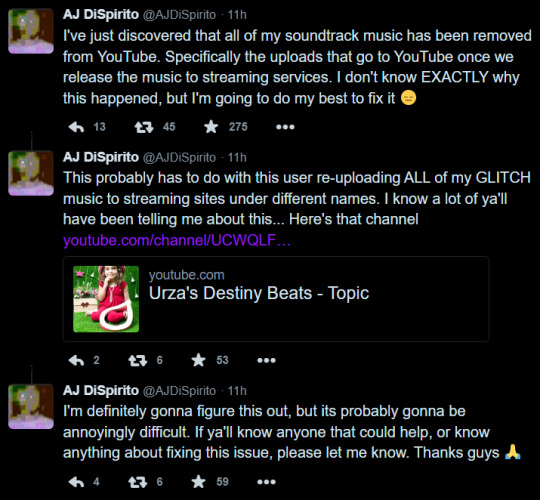
AJ DiSpirito, a composer who's scored or contributed music to many of Glitch Productions' shows (most recently Murder Drones), has run into an issue regarding his work's availability. On YouTube, direct links to the official, automatically-generated uploads for each song (different from the videos AJ himself posted, which are one per album) will lead to this error:


What's worse is that this is not confined to a single website or composer - it appears to have affected nearly every single streaming platform that previously hosted his work, as well as other Glitch soundtracks:
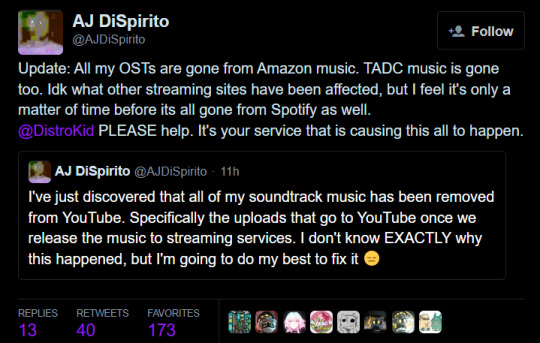
I did some investigating myself, and I can say two things with utmost certainty. The first is that, as he says in the above tweet, The Amazing Digital Circus's soundtracks were both pulled from YouTube in the same manner as his work on Murder Drones:
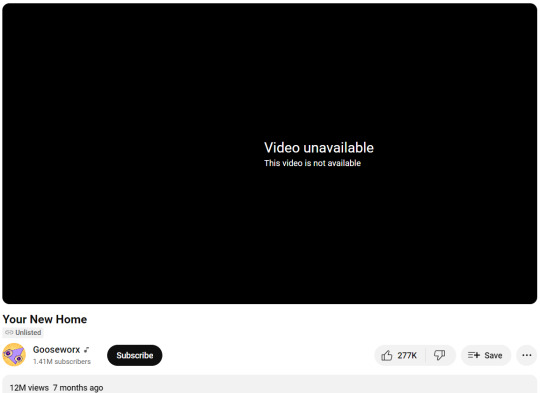

The second is that every single Glitch-related release on Qobuz - including their other shows, Meta Runner, Sunset Paradise, and SMG4 - has been delisted.

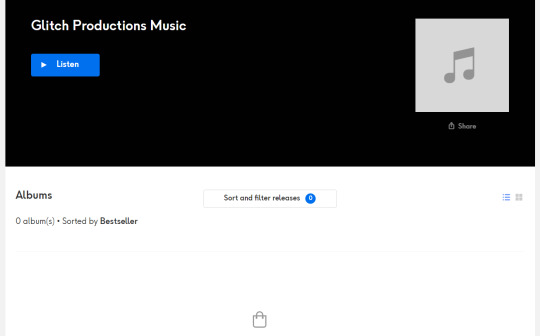
(The reason I highlight Qobuz specifically was simply because I had been meaning to buy Murder Drones' soundtrack there in the future, since it is the only place I know of where it can be purchased instead of just streamed.)
Finally, as mentioned at the very start of this post, this is likely tied to what appears to be a copyright troll reuploading DiSpirito's music for Glitch on YouTube and Amazon Music (among other places). "Urza's Destiny Beats" uses different names and (AI-generated) artwork for their uploads, but the actual music is undeniably stolen. Just a few examples:
"Festering Wound" is actually "Eternal Dream"
"Barrin, Master Wizard" is actually "The Knife Dance"
"Trumpet Blast" is actually "Solver Uzi"
In short, this is a pretty open and shut case. Considering both that and the many different artists who've been impacted, I'm hoping DistroKid (and/or any other relevant authorities) correct the problem soon - though I haven't heard great things about their track record for responsiveness.
Update #1: All Glitch music has been delisted from Spotify. Gooseworx (creator and co-composer of TADC) and the Lerdwichagul brothers (co-founders and heads of Glitch itself) are aware of the situation.
Update #2 (June 5th, 2024): The affected music is beginning to reappear! It's back up on YouTube and Apple Music, with other services likely to follow.
201 notes
·
View notes
Text
This is the first sequence I boarded for 304. Directed by Eugene Lee.
This is the version pre-revisions and lock, so, some parts here and there are different from the final, including script changes, but it is mostly there! The additions really plussed the sequence :D Please enjoy!
I love that Phil Bourassa designed Keyleth kind of like a Leshen. As a Witcher 3 fan, I had a fun time drawing her!
Property of Amazon Prime, Titmouse and Critical Role
Property of Critical Role
Prime Video
And Titmouse inc.
Do not reproduce, steal or reupload









#critical role#the legend of vox machina#keyleth#grog strongjaw#scanlan shorthalt#pike trickfoot#vaxildan#percival de rolo#vexahlia#storyboards#servan castillo
128 notes
·
View notes
Note
how does one manage when there's no feedback, no engagement, no... anything? the last few things i've published have gotten zero. it's frustrating. it's discouraging.
Getting No Feedback/Engagement
It's frustrating when you put your work out there and don't get any engagement or feedback. However, what to do about it (if anything at all) depends on how you're publishing and what you want the feedback for.
Whether you're publishing books/e-books or publishing online via your blog or a fiction-sharing site like AO3, it's never a good idea to rely on reader comments for feedback to help you improve your writing. If you want feedback for improvement, it's best to utilize alpha and beta readers, critique groups, critique partners, and feedback exchanges with other writers.
If you want the feedback an engagement because you want to know that someone is enjoying your work, or because you want to make sure you're building a following, you'll need to spend some time learning how to build an audience on the platform you're using. It's so important to remember that there are over 6 million registered users on AO3, for example, and over 11 million stories. Kindle Direct Publishing on Amazon hosts a couple million authors, with millions of books being sold each year. Tumblr has 135 million active users with 21 million new posts created each day. So, you no matter where you're publishing your stories, there is an unimaginable amount of competition. Unfortunately, you can't just post your stories and expect people to flock to them. That's why it's so important to learn how to build an audience on the particular platforms you're publishing on, and then you'll want to learn how to utilize social media to help get your work out there. For example, if you publish on a fiction-sharing site or your blog, you'll want to make sure you're using all the right tags and other metrics to draw people to your story. It's also extremely important that you support and engage with other writers... read and comment on their stories, boost them when appropriate. You might also consider starting a social media page specifically to find more readers. For example, let's say you write Supernatural fic and post it to AO3. You might make an Instagram page for your fiction, post SPN related memes and content, and update potential readers when new stories go up. Again, symbiosis is super important. If you don't engage with others, they won't engage with you.
If you're publishing books/e-books, you'll want to spend some time learning the best ways to promote your books, which will include things like figuring out who your audience is and where to find them, learning the proper tags, figuring out what kind of advertising speaks to them most, and learning to create promotional images and videos.
No matter what, it's really a matter of taking the time to get your work out there and find your audience. Because regardless of where you publish, they're unlikely to find you if you don't do the work to find them first.
Best of luck! ♥
•••••••••••••••••••••••••••••••••
I’ve been writing seriously for over 30 years and love to share what I’ve learned. Have a writing question? My inbox is always open!
♦ Questions that violate my ask policies will be deleted! ♦ Please see my master list of top posts before asking ♦ Learn more about WQA here
139 notes
·
View notes
Text
Here's a really nice article from Forbes on Mark and The Edge of Sleep! I really appreciate how this one portrays him! Much better than that Hollywood Reporter one.. >_>
(This article DOES make it sound like TEOS is *Mark's* show, however.. Which, if you weren't aware- Mark did not write or direct TEOS.)
Go watch The Edge of Sleep on Prime video!!

#markiplier#the edge of sleep#the edge of sleep on prime#prime video#mark fischbach#lio tipton#franz drameh#eve harlow#forbes
55 notes
·
View notes
Text
WatcherTV App Update

WatcherTV app is now available for download: Direct links: Google Play | Apple -On Roku and Amazon search for 'WatcherTV' all one word if you don't see it under 'Watcher'
WatcherTV apps include free trial -7 day free trial listed on apps (not website) -Annual discount of 30% off before May 30th still available if you sign up on the website, then login on your chosen app
New comment section! -There's now a comment section under new videos -Comments are public to all, even those without an account, but you must sign in to reply or like a comment
115 notes
·
View notes